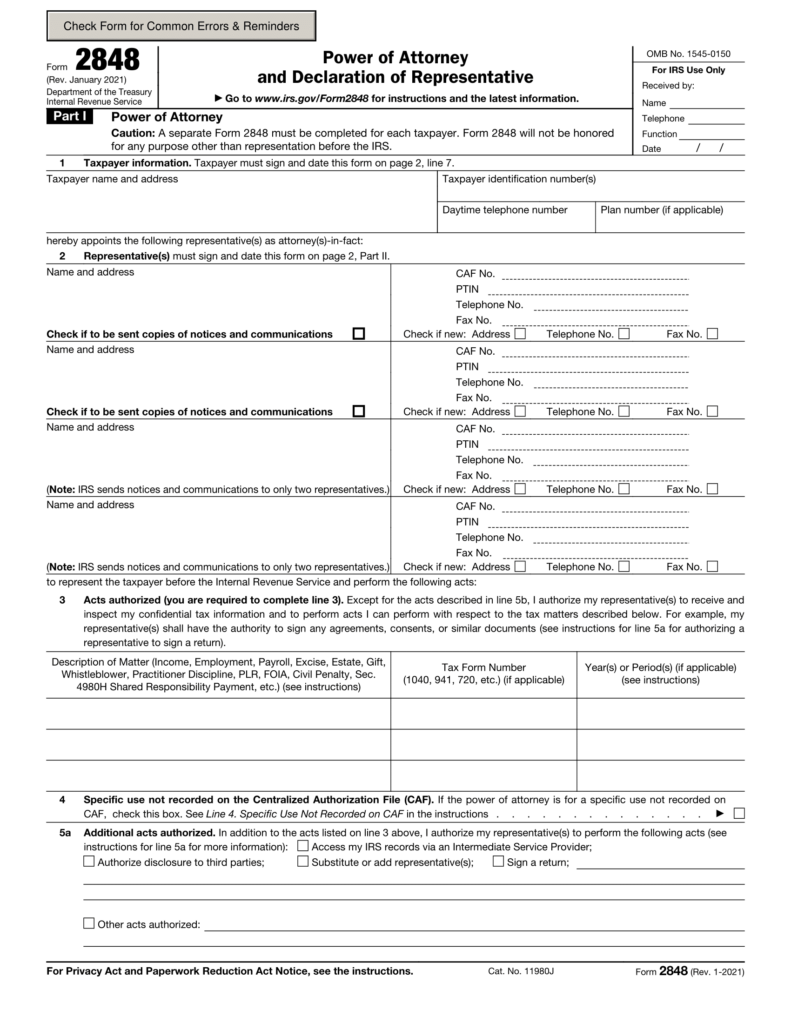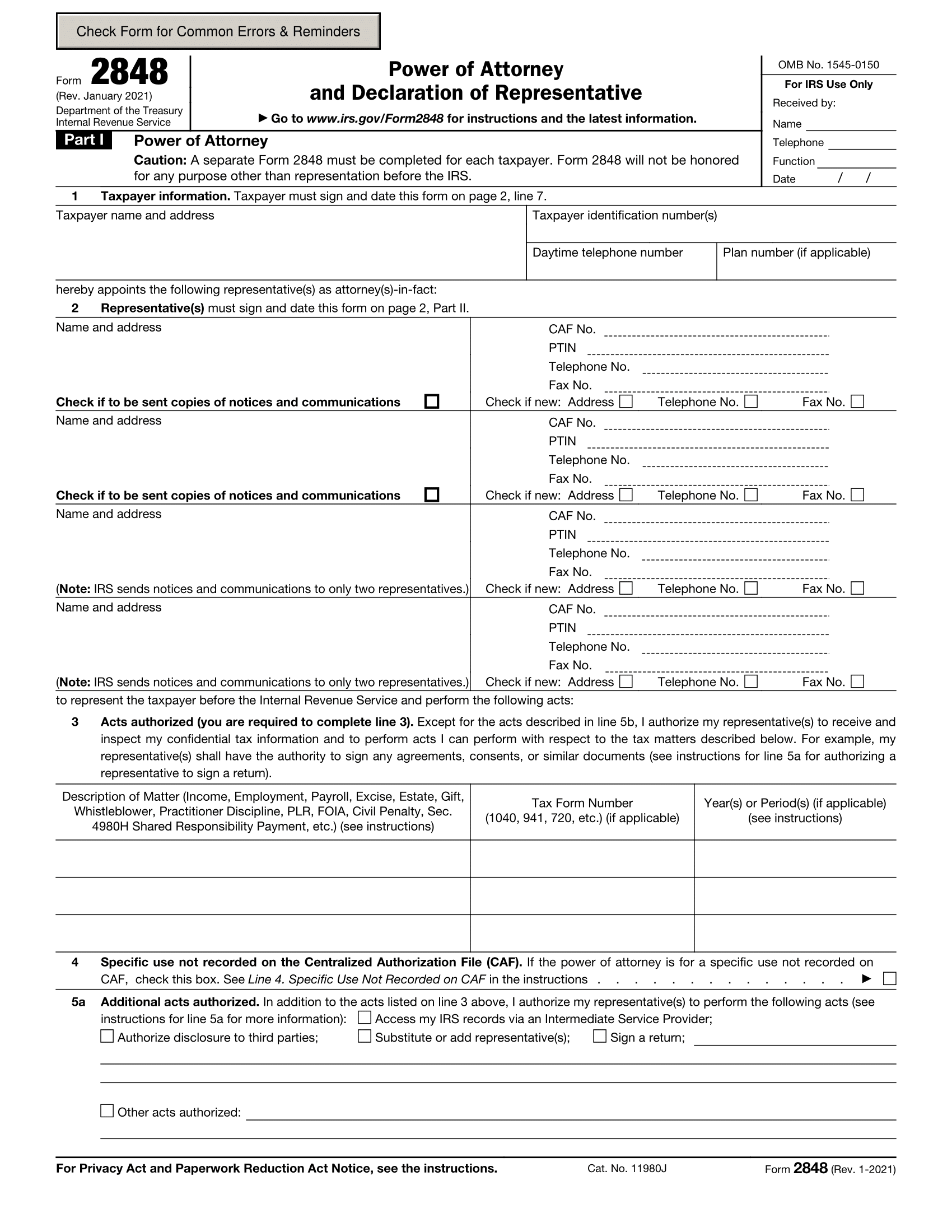IRS Form 2848, Power of Attorney and Declaration of Representative, is a tax power of attorney form that allows another person, usually an accountant, to handle tax-related activities on your behalf.
With your tax form on file, your authorized representative can access records and perform tax-specific tasks as permitted by state laws and IRS regulations.
When to Use
There are various tax matters and situations where an IRS Form 2848 Power of Attorney might be used, some of which include:
- Submitting and signing a tax return.
- Arranging a tax payment plan.
- Obtaining IRS correspondence and notices.
- Obtaining transcripts of your previous tax returns.
- Responding to IRS correspondence.
- Disputing or appealing IRS decisions.
IRS Form 2848 vs. General Power of Attorney
While Form 2848 does grant power of attorney, it is much more restrictive than generic power of attorney forms. IRS Form 2848 allows you, the taxpayer, to designate an eligible individual to represent your interests with the IRS for specific matters relating to taxes.
With a general power of attorney form, you grant your representative the authority to handle a broader scope of powers, including other financial matters, property, or healthcare decisions.
Granted Authority of Form 2848
A 2848 Form grants power of attorney to your chosen representative. Once they receive power of attorney, the named agent can represent you in IRS dealings and tax matters. As the primary filer, you can choose which powers to grant your representative within legal guidelines. Such powers may include:
- Preparing and signing agreements
- Creating and approving consents and waivers
- Requesting and reviewing IRS tax records
The agent authorized under IRS Form 2848 does have certain limitations. For instance, unless specifically provided in the power of attorney, they may not have the power to substitute or add another representative, complete payments, or provide your private tax information to third parties. In addition, access is typically limited to tax records within a specific time frame.
To qualify as a candidate for power of attorney under the authorization form, your agent must be eligible per IRS regulations. Individuals who may qualify include attorneys, actuaries, accountants, tax preparation specialists, or family members of the taxpayer.
Where Can I File Form 2848?
You can file the IRS form using one of three methods:
- File the form online through the IRS portal
- By fax to the appropriate IRS office (see below)
- By mail to the appropriate IRS office (see below)
IRS Fax and Mail for Form 2848 Submissions
You can send the signed and completed IRS Form 2848, Power of Attorney and Declaration of Representative, to your regional IRS office based on your state of residence. The paperwork is received by three national centers located in Tennessee, Utah, and Pennsylvania. You can refer to the following table for filing directions:
| Filing State | Fax To | Mail To |
|---|---|---|
| AL, AR, CT, DE, DC, FL, GA, IL, IN, KY, LA, ME, MD, MA MI, MS, NH, NJ, NY, NC, OH, PA, RI, SC, TN, VT, VA, WV | 855-214-7519 | Internal Revenue Service 5333 Getwell Rd Stop 8423 Memphis, TN 38118 |
| AK, AZ, CA, CO, HI, ID, IA, KS, MN, MO, MT, NE, NV, NM, ND, OK, OR, SD, TX, UT, WA, WI, WY | 855-214-7522 | Internal Revenue Service 1973 Rulon White Blvd. MS 6737 Ogden, UT 84201 |
| Addresses outside the contiguous US, including Guam, the US Virgin Islands, Puerto Rico, the Northern Mariana Islands, American Samoa, APO and FPO addresses, and foreign countries | 855-772-3156 304-707-9785 (if outside the US) | Internal Revenue Service International CAF Team 2970 Market Street MS: 4-H14.123. Philadelphia, PA 19104 |
These fax numbers and addresses are subject to change. Before submitting your form, check the IRS website for the most current information.
Instructions For Filling Out Form 2848
IRS Form 2848 can be complicated, and accuracy is critical to avoid complications with the IRS. Follow these instructions to simplify the process.
Step 1: Confirm Your Client’s Identity
Before you begin the process, confirm the taxpayer’s identity. If they are a representative of an organization, verify that they are authorized to convey power of attorney. For an individual client, a photo ID, social security card, passport, or other documentation may suffice.
Step 2: Enter Taxpayer and Representative Information
On line 1, add the taxpayer’s full name, mailing address, identification number, and phone number. For an organization, use the taxpayer’s Federal Tax ID number or Employer Identification Number (EIN). A social security number (SSN) is the standard taxpayer identification number for an individual filer.
On line 2, enter the representative’s full name, mailing address, telephone, and fax number. Note that you can name more than one representative. Enter the representative’s Centralized Authorization File (CAF) number, a unique nine-digit number assigned by the IRS to representatives.
If your representative does not have a CAF number, enter “None,” and the IRS will assign one directly to the representative.
Step 3: Enter Authorized Acts and Unauthorized Acts
Indicate the specific documents and information the representative is authorized to access, including a description of the matter, tax form number, and applicable year(s) or period(s) on line 3.
Then, on line 5a, specify any additional actions the representative is allowed to perform on behalf of the taxpayer, such as signing tax returns, authorizing disclosure to third parties, or adding representatives.
On line 5b, you can indicate specific acts the representative is not authorized to perform under this IRS power of attorney. This may include endorsing checks or payments, negotiating payments, or directing payments to any account other than the taxpayer.
Step 4: CAF Recording and Prior Power of Attorney
Generally, powers of attorney are recorded in the IRS CAF system. However, a specific-use power of attorney, a one-time or specific-issue grant of authority to a representative, is exempt from being recorded. Check the box on line 4 if the power of attorney is for a non-recorded specific use.
The IRS automatically revokes all previous power(s) of attorney on file with the IRS unless you request otherwise. You can request that previous power(s) of attorney remain intact by checking the box on line 6.
Step 5: Taxpayer and Representative Sign the IRS Form
The taxpayer should sign and date the taxpayer declaration on line 7, formally approving the representative’s legal authority as defined in the IRS form.
The representative(s) must sign in Part II Declaration of Representative and also enter their:
- Designation code
- Licensing jurisdiction (state) or other licensing authority (if applicable)
- Bar, certification, registration, or license number (if applicable)
Step 6: Submit Form 2848
Once the form is complete, fax or mail it to the appropriate IRS office. You can also submit it online via the new IRS authorization tool.
How to Revoke IRS Power of Attorney Form 2848
Typically, an IRS power of attorney will remain in effect for seven years. If you wish to change representatives or rescind the POA, you can revoke your authorization form as follows:
- Print a copy of your Form 2848
- Write “REVOKE” across the top of the first page
- Add your signature and the current date immediately below the annotation
- Mail or fax a copy of the Form 2848 with the “REVOKE” annotation to the appropriate IRS office (see the above chart)
You can also submit a statement of revocation if you do not have a copy of Form 2848 to be revoked. Indicate the matters and time periods you want the revocation to apply to, as well as the names and addresses of the representatives whose authority you are removing. Sign and date the statement and send it to the appropriate IRS office by fax or mail.
Can I Substitute Form 2848?
If the taxpayer is incapacitated or incompetent, the IRS may accept a durable power of attorney or springing power of attorney in lieu of a tax form like Form 2848. Since these POAs are often limited, they should be established during estate planning so they can be used in the event the taxpayer becomes unable to complete a Form 2848.
IRS Power of Attorney Form 2848 Sample
Streamline your power of attorney designation by downloading a fillable IRS power of attorney tax Form 2848 in PDF.


